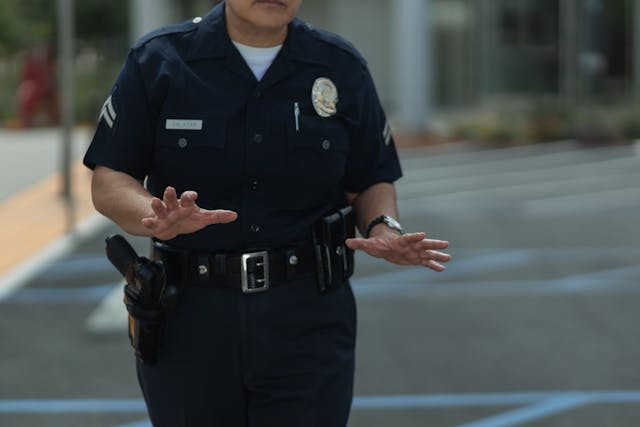
Tonfas in modern security roles: beyond martial arts
Originally developed as a traditional Okinawan farming tool, the tonfa has since transitioned into a widely respected martial arts weapon. Its L-shaped design and rotating grip made it a dynamic addition to martial disciplines like kobudo. However, the evolution of modern law enforcement and private security practices has brought the tonfa into a new context—well beyond the boundaries of the dojo. Today, the tonfa plays a vital role in non-lethal defense strategies used by security professionals around the globe.
 In the hands of a trained officer, the tonfa offers both defensive and offensive capabilities. Its unique structure allows for rotational strikes, forearm shielding, and joint control—all while reducing the risk of permanent injury to the subject. Unlike straight batons, the tonfa provides more versatility in close-quarters scenarios and allows for quicker reaction time during confrontations. For security units seeking practical, non-lethal tools that prioritize control and technique, Dekkade provides a selection of modern tonfas designed specifically for professional use in demanding environments.
In the hands of a trained officer, the tonfa offers both defensive and offensive capabilities. Its unique structure allows for rotational strikes, forearm shielding, and joint control—all while reducing the risk of permanent injury to the subject. Unlike straight batons, the tonfa provides more versatility in close-quarters scenarios and allows for quicker reaction time during confrontations. For security units seeking practical, non-lethal tools that prioritize control and technique, Dekkade provides a selection of modern tonfas designed specifically for professional use in demanding environments.
A major advantage of the tonfa lies in its ability to create a natural guard. When held along the forearm, it functions as a shield against punches, blunt force attacks, or even edged weapons. This defensive stance reduces exposure while keeping the user’s striking ability readily available. Such utility is particularly valuable in crowd control or riot situations, where rapid changes in engagement distance and threat level demand versatile tools.
Many modern tonfas are made from durable materials such as polycarbonate or reinforced polymers. These enhancements allow the tool to withstand heavy use without sacrificing mobility. Some models are collapsible for easier storage and transport, while others feature textured grips or ergonomic designs to reduce fatigue during extended duty. The transition from traditional wooden variants to tactical-grade models reflects the changing needs of today’s security landscape.
Training is critical to effective tonfa deployment. Security personnel must be taught not only how to strike or block, but also how to de-escalate situations without unnecessary force. The tonfa lends itself well to compliance techniques, including limb control and pressure-point application, which can help subdue aggressive individuals with minimal injury. Departments that incorporate tonfa training often report greater control during arrests and a reduction in excessive-force complaints.
In correctional facilities, tonfas offer guards a means of protection that discourages escalation. The visual presence of the tool alone can act as a deterrent, while its function enables staff to defend themselves without drawing firearms. This makes it especially suitable in environments where the use of lethal force is discouraged or outright prohibited. Additionally, the tonfa’s compactness allows for quick movement through tight hallways or crowded rooms, which is often not feasible with longer batons or shields.
Private security companies are also adopting the tonfa as part of their equipment arsenal. From protecting corporate assets to patrolling event venues, guards equipped with tonfas maintain a balance of authority and non-lethal capability. This tool is also beneficial for bodyguards who require discreet, efficient protection methods in high-profile settings. Training programs increasingly include tonfa certification as part of broader close-protection and defensive tactics curricula.
In many countries, legal frameworks favor the use of tonfas over more aggressive or invasive options. Due to their non-lethal classification, they are often allowed in environments where firearms or tasers are restricted. However, legality can vary widely, and users must stay informed about regional laws regarding possession, carry, and usage. In some jurisdictions, tonfas are restricted to licensed personnel or require specific certifications.
The adoption of the tonfa in modern policing isn’t just about physical defense—it also aligns with evolving philosophies of community safety and minimal force. As public scrutiny of law enforcement intensifies, agencies are under pressure to use tools that emphasize control, responsibility, and proportional response. The tonfa embodies these principles. Its effectiveness relies not on aggression, but on discipline, technique, and presence of mind.
From traditional martial roots to cutting-edge tactical environments, the tonfa has proven its adaptability and continued relevance. Its resurgence in modern security roles is no accident—it’s the result of a growing need for tools that offer protection without excess, precision without overreach, and versatility without complexity. For security professionals who value skill over brute strength, the tonfa is more than a tool—it’s an extension of training and trust.
